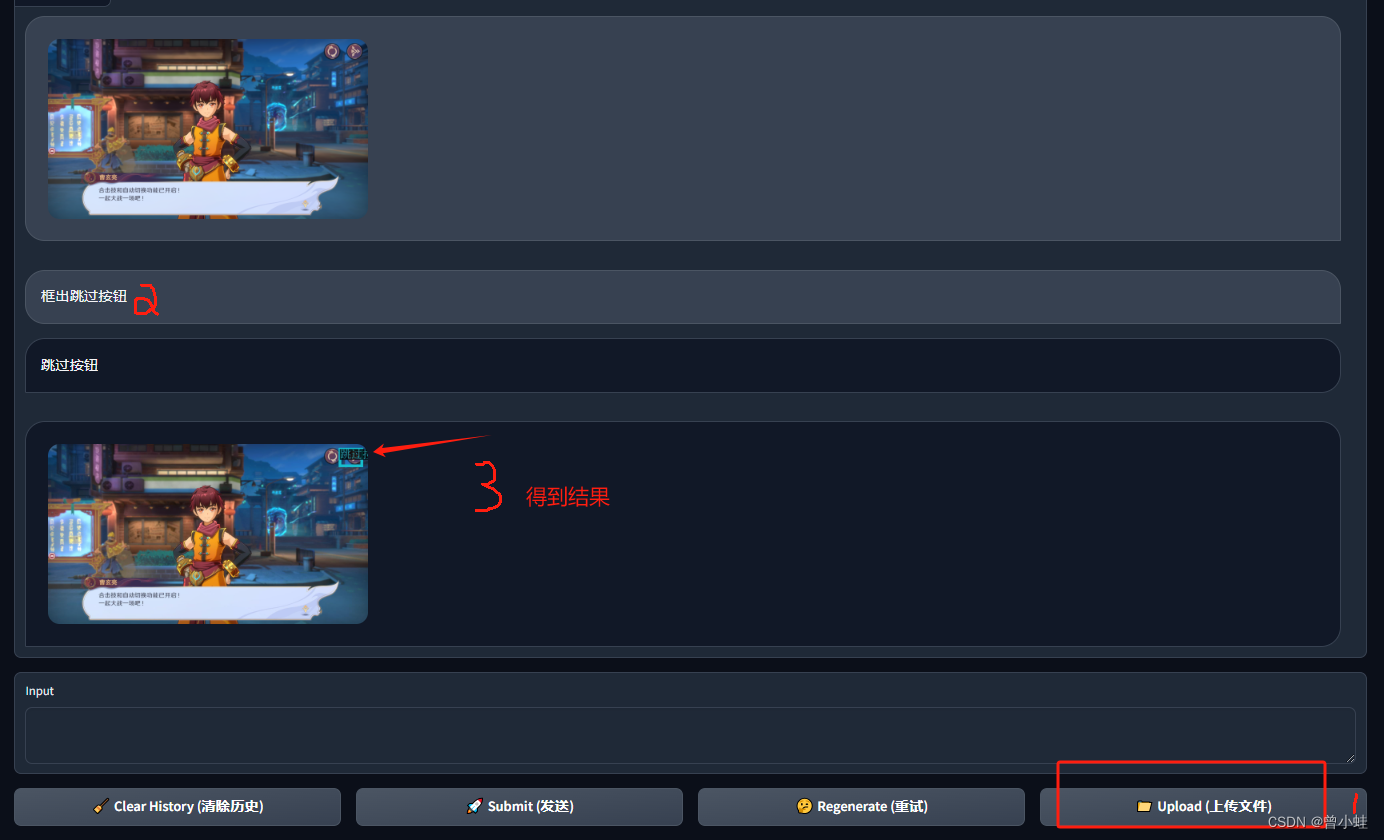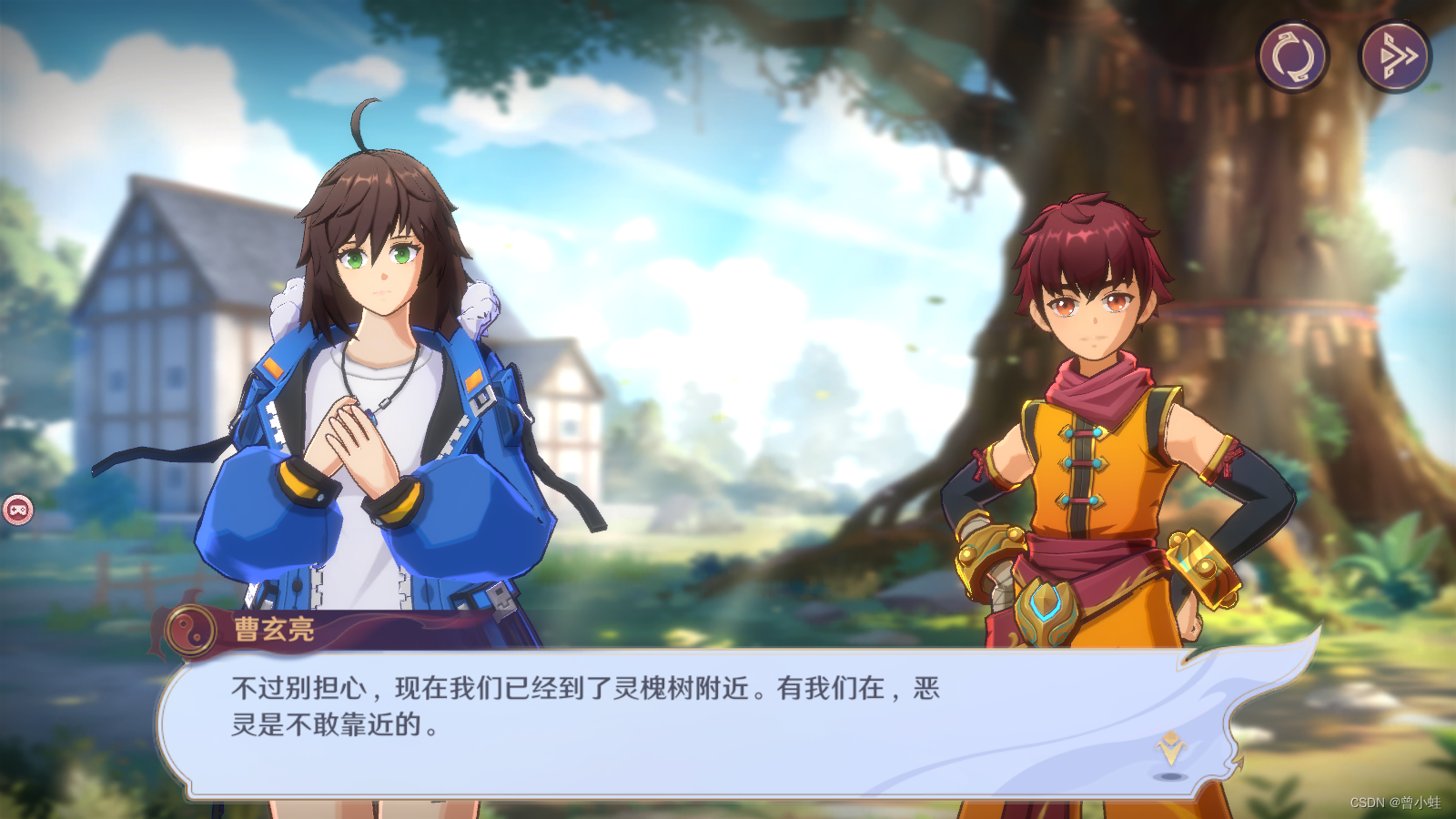- 1vue3初始搭建项目完整教程 vue3 + vite + element-ui + axios_vue3初始化项目
- 2软件测试面试怎么介绍项目,看完这5点就够了_软件测试项目具体介绍
- 3Spring Boot+Kafka实战生产级Kafka消费组_springboot kafka消费
- 4Android第三方开发包值高德地图SDK使用介绍_com.amap.api:3dmap
- 5大突破!本地大模型接入微软Autogen,多专家Agent共事成现实!支持llama2+chatglm,附代码!_llm agent可本地化
- 6移动云:连接未来的智慧之旅_移动云 kms
- 7【Git远程操作】克隆远程仓库 https协议 | ssh协议
- 8爆肝将近 10 万字进行讲解 Node.Js 超详细教程_nodejs
- 9Flink,spark对比
- 10git 拉取项目指定目录或者指定文件_git拉取指定文件夹
1张图片+3090显卡微调Qwen-VL视觉语言大模型(仅做演示、效果还需加大数据量)_qwen-vl 微调
赞
踩
原项目地址:https://github.com/QwenLM/Qwen-VL/blob/master/README_CN.md

环境+本地部署(见之前博文)
【本地部署 】23.08 阿里Qwen-VL:能对图片理解、定位物体、读取文字的视觉语言模型 (推理最低12G显存+)
一、数据集格式说明
https://github.com/QwenLM/Qwen-VL/blob/master/README_CN.md#微调
所有样本放到一个列表中并存入json文件中
每个样本对应一个字典,包含id和conversation,conversation为一个列表
1.1 纯文本对话示例
为针对多样的VL任务,我们增加了一下的特殊tokens:
[
{
"id": "identity_0",
"conversations": [
{
"from": "user",
"value": "你好"
},
{
"from": "assistant",
"value": "我是Qwen-VL,一个支持视觉输入的大模型。"
}
]
},
]
- 1
- 2
- 3
- 4
- 5
- 6
- 7
- 8
- 9
- 10
- 11
- 12
- 13
- 14
- 15
1.2 图片解读+标记位置
引入特殊token,表示图片和检测框相关
<img> </img> <ref> </ref> <box> </box>.
- 1
对于带图像输入的内容可表示为
Picture id: <img>img_path</img>\n {your prompt},其中id表示对话中的第几张图片。
其中"img_path" 可以是本地的图片或网络地址。
- 1
- 2
对话中的检测框可以表示
<box>(x1,y1),(x2,y2)</box>
其中 (x1, y1) 和(x2, y2)分别对应左上角和右下角的坐标,并且被归一化到[0, 1000)的范围内
检测框对应的文本描述也可以通过<ref>text_caption</ref>表示。
- 1
- 2
- 3
示例1
{ "id": "identity_1", "conversations": [ { "from": "user", "value": "Picture 1: <img>https://qianwen-res.oss-cn-beijing.aliyuncs.com/Qwen-VL/assets/demo.jpeg</img>\n图中的狗是什么品种?" }, { "from": "assistant", "value": "图中是一只拉布拉多犬。" }, { "from": "user", "value": "框出图中的格子衬衫" }, { "from": "assistant", "value": "<ref>格子衬衫</ref><box>(588,499),(725,789)</box>" } ] },
- 1
- 2
- 3
- 4
- 5
- 6
- 7
- 8
- 9
- 10
- 11
- 12
- 13
- 14
- 15
- 16
- 17
- 18
- 19
- 20
- 21
示例2 多图片解析
[ ... { "id": "identity_2", "conversations": [ { "from": "user", "value": "Picture 1: <img>assets/mm_tutorial/Chongqing.jpeg</img>\nPicture 2: <img>assets/mm_tutorial/Beijing.jpeg</img>\n图中都是哪" }, { "from": "assistant", "value": "第一张图片是重庆的城市天际线,第二张图片是北京的天际线。" } ] } ... ]
- 1
- 2
- 3
- 4
- 5
- 6
- 7
- 8
- 9
- 10
- 11
- 12
- 13
- 14
- 15
- 16
- 17
二、制作自己的数据集
利用opencv手动对图片打标,获得box坐标
记得修改 需要打标图片路径 folder_path = r’D:\code\Qwen-VL\datasets\Screenshots’
修改保存到本地txt的
def normalize_and_save(start, end, width, height,image_path,save_txt=‘coordinates3.txt’):
# anthor zxy+chatgpt import cv2 import os import numpy as np # 初始化矩形框的起始和结束点 start_point = None end_point = None # 标记是否正在绘制 drawing = False # 鼠标回调函数 def draw_rectangle(event, x, y, flags, param): global start_point, end_point, drawing if event == cv2.EVENT_LBUTTONDOWN: drawing = True start_point = (x, y) elif event == cv2.EVENT_MOUSEMOVE: if drawing: end_point = (x, y) elif event == cv2.EVENT_LBUTTONUP: drawing = False end_point = (x, y) # 绘制矩形 cv2.rectangle(img, start_point, end_point, (0, 255, 0), 2) # 归一化并保存坐标 normalize_and_save(start_point, end_point, img.shape[1], img.shape[0],image_path) # 归一化坐标并保存到txt文件 def normalize_and_save(start, end, width, height,image_path,save_txt='coordinates3.txt'): normalized_start = (int(start[0] * 1000 / width), int(start[1] * 1000 / height)) normalized_end = (int(end[0] * 1000 / width), int(end[1] * 1000 / height)) with open(save_txt, 'a') as file: print('image_path',image_path) file.write(f"{image_path}:<box>({normalized_start[0]}, {normalized_start[1]}),({normalized_end[0]}, {normalized_end[1]})</box>\n") # 导入图片文件夹 # opencv最好路径是中文的 folder_path = r'D:\code\Qwen-VL\datasets\Screenshots' images = [os.path.join(folder_path, img) for img in os.listdir(folder_path) if img.endswith(('.png', '.jpg', '.jpeg'))] # 创建窗口并设置鼠标回调 cv2.namedWindow('Image') cv2.setMouseCallback('Image', draw_rectangle) for image_path in images: print('image_path',image_path) img = cv2.imread(image_path) while True: cv2.imshow('Image', img) key = cv2.waitKey(1) & 0xFF if key == ord('n'): # 按 'n' 键继续到下一张图片 break if key == ord('q'): cv2.destroyAllWindows() exit(0) # 清除所有绘制的矩形,准备下一张图片 img = cv2.imread(image_path) # 重新加载原图 cv2.destroyAllWindows()
- 1
- 2
- 3
- 4
- 5
- 6
- 7
- 8
- 9
- 10
- 11
- 12
- 13
- 14
- 15
- 16
- 17
- 18
- 19
- 20
- 21
- 22
- 23
- 24
- 25
- 26
- 27
- 28
- 29
- 30
- 31
- 32
- 33
- 34
- 35
- 36
- 37
- 38
- 39
- 40
- 41
- 42
- 43
- 44
- 45
- 46
- 47
- 48
- 49
- 50
- 51
- 52
- 53
- 54
- 55
- 56
- 57
- 58
- 59
- 60
- 61
- 62
- 63
- 64
- 65
手动打标结果

自己的数据集 zhj_box.json(仅仅示意)

也可自己修改图片的路径
./datasets/zhj_box/162531.png
[ { "id": "000000000", "conversations": [ { "from": "user", "value": "Picture 1: <img>./datasets/zhj_box/162531.png</img>\n这是什么?" }, { "from": "assistant", "value": "这是镇魂街游戏对话界面,有继续对话按钮,重新加载,跳过。" }, { "from": "user", "value": "框出跳过剧情按钮?" }, { "from": "assistant", "value": "<ref>跳过剧情按钮</ref><box>(926, 20),(981, 122)</box>" } ] } ]
- 1
- 2
- 3
- 4
- 5
- 6
- 7
- 8
- 9
- 10
- 11
- 12
- 13
- 14
- 15
- 16
- 17
- 18
- 19
- 20
- 21
- 22
- 23
- 24
三、linux下使用3090训练
git clone https://github.com/QwenLM/Qwen-VL.git
cd QWEN-VL
- 1
- 2
将图片放到特定路径
./datasets/zhj_box/ ,如果需要修改,请记得在json里面改,都是相对整个工程文件
并修改脚本
复制 finetune\finetune_lora_single_gpu.sh 到 finetune_lora_single_gpu_zhj_0423.sh (然后修改)
DATA=“./datasets/zhj_box.json” 表示我们制作的数据集
–output_dir output_qwen2/ 表示输出路径自己可修改

#!/bin/bash export CUDA_DEVICE_MAX_CONNECTIONS=1 DIR=`pwd` MODEL="你自己的qwen-vl大模型地址/.cache/modelscope/hub/qwen/Qwen-VL-Chat" #"Qwen/Qwen-VL-Chat"/"Qwen/Qwen-VL" Set the path if you do not want to load from huggingface directly # ATTENTION: specify the path to your training data, which should be a json file consisting of a list of conversations. # See the section for finetuning in README for more information. DATA="./datasets/zhj_box/zhj_box.json" export CUDA_VISIBLE_DEVICES=0 python finetune.py \ --model_name_or_path $MODEL \ --data_path $DATA \ --bf16 True \ --fix_vit True \ --output_dir output_qwen2/ \ --num_train_epochs 12 \ --per_device_train_batch_size 1 \ --per_device_eval_batch_size 1 \ --gradient_accumulation_steps 1 \ --evaluation_strategy "no" \ --save_strategy "steps" \ --save_steps 20 \ --save_total_limit 1 \ --learning_rate 2e-4 \ --weight_decay 0.1 \ --adam_beta2 0.95 \ --warmup_ratio 0.01 \ --lr_scheduler_type "cosine" \ --logging_steps 1 \ --report_to "none" \ --model_max_length 512 \ --lazy_preprocess True \ --gradient_checkpointing \ --use_lora
- 1
- 2
- 3
- 4
- 5
- 6
- 7
- 8
- 9
- 10
- 11
- 12
- 13
- 14
- 15
- 16
- 17
- 18
- 19
- 20
- 21
- 22
- 23
- 24
- 25
- 26
- 27
- 28
- 29
- 30
- 31
- 32
- 33
- 34
- 35
- 36
- 37
四、推理 (web_demo_mm_lora.py)
运行命令
python web_demo_mm_lora.py -c 你的绝对路径/Qwen-VL/output_qwen2 --server-name 0.0.0.0 --server-port 8002
- 1
–server-port 8000~8010随便写
-c 是训练的lora路径,记得
CUDA_VISIBLE_DEVICES=0 可用于指定显卡
4.1 web_demo_mm_lora.py
# Copyright (c) Alibaba Cloud.
#
# This source code is licensed under the license found in the
# LICENSE file in the root directory of this source tree.
"""A simple web interactive chat demo based on gradio."""
from argparse import ArgumentParser
from pathlib import Path
import copy
import gradio as gr
import os
import re
import secrets
import tempfile
from modelscope import (
snapshot_download, AutoModelForCausalLM, AutoTokenizer, GenerationConfig
)
from peft import AutoPeftModelForCausalLM
DEFAULT_CKPT_PATH = '/data/zengxingyu/code/Qwen-VL/output_qwen'
BOX_TAG_PATTERN = r"<box>([\s\S]*?)</box>"
PUNCTUATION = "!?。"#$%&'()*+,-/:;<=>@[\]^_`{|}~⦅⦆「」、、〃》「」『』【】〔〕〖〗〘〙〚〛〜〝〞〟〰〾〿–—‘’‛“”„‟…‧﹏."
def _get_args():
parser = ArgumentParser()
parser.add_argument("-c", "--checkpoint-path", type=str, default=DEFAULT_CKPT_PATH,
help="Checkpoint name or path, default to %(default)r")
parser.add_argument("--cpu-only", action="store_true", help="Run demo with CPU only")
parser.add_argument("--share", action="store_true", default=False,
help="Create a publicly shareable link for the interface.")
parser.add_argument("--inbrowser", action="store_true", default=False,
help="Automatically launch the interface in a new tab on the default browser.")
parser.add_argument("--server-port", type=int, default=8000,
help="Demo server port.")
parser.add_argument("--server-name", type=str, default="0.0.0.0",
help="Demo server name.")
args = parser.parse_args()
return args
def _load_model_tokenizer(args):
tokenizer = AutoTokenizer.from_pretrained(
args.checkpoint_path, trust_remote_code=True, resume_download=True, revision='master',
)
if args.cpu_only:
device_map = "cpu"
else:
device_map = "cuda"
model = AutoPeftModelForCausalLM.from_pretrained(
"/data/zengxingyu/code/Qwen-VL/output_qwen", # path to the output directory
device_map="auto",
trust_remote_code=True).eval()
model.generation_config = GenerationConfig.from_pretrained(
args.checkpoint_path, trust_remote_code=True, resume_download=True, revision='master',
)
return model, tokenizer
def _parse_text(text):
lines = text.split("\n")
lines = [line for line in lines if line != ""]
count = 0
for i, line in enumerate(lines):
if "```" in line:
count += 1
items = line.split("`")
if count % 2 == 1:
lines[i] = f'<pre><code class="language-{items[-1]}">'
else:
lines[i] = f"<br></code></pre>"
else:
if i > 0:
if count % 2 == 1:
line = line.replace("`", r"\`")
line = line.replace("<", "<")
line = line.replace(">", ">")
line = line.replace(" ", " ")
line = line.replace("*", "*")
line = line.replace("_", "_")
line = line.replace("-", "-")
line = line.replace(".", ".")
line = line.replace("!", "!")
line = line.replace("(", "(")
line = line.replace(")", ")")
line = line.replace("$", "$")
lines[i] = "<br>" + line
text = "".join(lines)
return text
def _remove_image_special(text):
text = text.replace('<ref>', '').replace('</ref>', '')
return re.sub(r'<box>.*?(</box>|$)', '', text)
def _launch_demo(args, model, tokenizer):
uploaded_file_dir = os.environ.get("GRADIO_TEMP_DIR") or str(
Path(tempfile.gettempdir()) / "gradio"
)
def predict(_chatbot, task_history):
chat_query = _chatbot[-1][0]
query = task_history[-1][0]
print("User: " + _parse_text(query))
history_cp = copy.deepcopy(task_history)
full_response = ""
history_filter = []
pic_idx = 1
pre = ""
for i, (q, a) in enumerate(history_cp):
if isinstance(q, (tuple, list)):
q = f'Picture {pic_idx}: <img>{q[0]}</img>'
pre += q + '\n'
pic_idx += 1
else:
pre += q
history_filter.append((pre, a))
pre = ""
history, message = history_filter[:-1], history_filter[-1][0]
# response, history = model.chat(tokenizer, message, history=history)
for response in model.chat_stream(tokenizer, message, history=history):
_chatbot[-1] = (_parse_text(chat_query), _remove_image_special(_parse_text(response)))
yield _chatbot
full_response = _parse_text(response)
response = full_response
history.append((message, response))
image = tokenizer.draw_bbox_on_latest_picture(response, history)
if image is not None:
temp_dir = secrets.token_hex(20)
temp_dir = Path(uploaded_file_dir) / temp_dir
temp_dir.mkdir(exist_ok=True, parents=True)
name = f"tmp{secrets.token_hex(5)}.jpg"
filename = temp_dir / name
image.save(str(filename))
_chatbot.append((None, (str(filename),)))
else:
_chatbot[-1] = (_parse_text(chat_query), response)
# full_response = _parse_text(response)
task_history[-1] = (query, full_response)
print("Qwen-VL-Chat: " + _parse_text(full_response))
yield _chatbot
def regenerate(_chatbot, task_history):
if not task_history:
return _chatbot
item = task_history[-1]
if item[1] is None:
return _chatbot
task_history[-1] = (item[0], None)
chatbot_item = _chatbot.pop(-1)
if chatbot_item[0] is None:
_chatbot[-1] = (_chatbot[-1][0], None)
else:
_chatbot.append((chatbot_item[0], None))
return predict(_chatbot, task_history)
def add_text(history, task_history, text):
task_text = text
if len(text) >= 2 and text[-1] in PUNCTUATION and text[-2] not in PUNCTUATION:
task_text = text[:-1]
history = history + [(_parse_text(text), None)]
task_history = task_history + [(task_text, None)]
return history, task_history, ""
def add_file(history, task_history, file):
history = history + [((file.name,), None)]
task_history = task_history + [((file.name,), None)]
return history, task_history
def reset_user_input():
return gr.update(value="")
def reset_state(task_history):
task_history.clear()
return []
with gr.Blocks() as demo:
gr.Markdown("""\
<p align="center"><img src="https://modelscope.cn/api/v1/models/qwen/Qwen-7B-Chat/repo?
Revision=master&FilePath=assets/logo.jpeg&View=true" style="height: 80px"/><p>""")
gr.Markdown("""<center><font size=8>Qwen-VL-Chat Bot</center>""")
gr.Markdown(
"""\
<center><font size=3>This WebUI is based on Qwen-VL-Chat, developed by Alibaba Cloud. \
(本WebUI基于Qwen-VL-Chat打造,实现聊天机器人功能。)</center>""")
gr.Markdown("""\
<center><font size=4>Qwen-VL <a href="https://modelscope.cn/models/qwen/Qwen-VL/summary">声明:本文内容由网友自发贡献,不代表【wpsshop博客】立场,版权归原作者所有,本站不承担相应法律责任。如您发现有侵权的内容,请联系我们。转载请注明出处:https://www.wpsshop.cn/w/代码探险家/article/detail/870713Copyright © 2003-2013 www.wpsshop.cn 版权所有,并保留所有权利。



